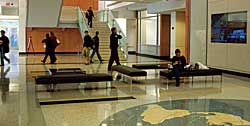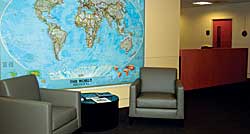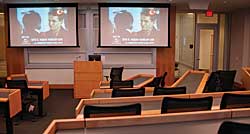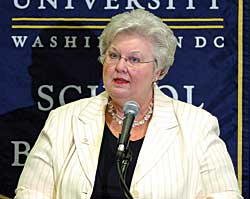|

By Jamie L. Freedman
Walking through the doors of the
gleaming, new Ric and Dawn Duquès Hall,
there’s no doubt about it—GW’s
School of Business is on the rise.
University dignitaries, led by GW President Stephen
Joel Trachtenberg and Board of Trustees Chair
Charles T. Manatt, filled the building’s
Oglethorpe Great Hall (named for Raymond J. Oglethorpe,
MS ’69)
Feb. 8 to officially open the University’s
newest academic center. The ribbon-cutting followed
a keynote speech delivered for the grand opening
event by FedEx Chairman and President Frederick
W. Smith.

|

A highlight of the first-floor atrium is a world map in the terrazzo
floor.
Julie Woodford
|
The new facility features an impressive Capital
Markets Room—a simulated training room—27
state-of-the art classrooms with built-in audiovisual
technology and executive-style chairs, a 115-seat
auditorium, 19 team rooms, three computer labs,
spacious student lounges and study areas, and
a career center. Connected on four floors to
the renovated Norma Lee and Morton Funger Hall,
the vanguard facility brings the School of Business’ nine
academic units, plus many related programs and
services, under one roof. Academic departments
were previously scattered throughout campus in
eight different locations.
“Buildings alone don’t teach,” Trachtenberg
said. “But it’s important not to
underestimate the psychological and educational
significance of architecture and edifice … Buildings
like Duquès and Funger halls provide us
with the space, the technology, and the modalities
that are absolutely necessary for the contemporary
study of business.”
School of Business faculty and staff members
began moving into their new six-story home
on 22nd Street in December. Duquès, the hub
of business student activity, houses high-tech
classrooms, student services, student lounges,
and break-out rooms, while redesigned Funger
is home to the majority of the school’s
faculty offices and conference rooms. The facility
also features 194 underground parking spaces,
an executive conference center, a student business
center, a Java City food venue, and a state-of-the-art
behavioral lab, equipped with two-way mirrors,
where marketing students can observe and study
focus groups.

Funger Hall renovations allowed the
business school faculty and staff members
to move in to larger offices with conference
rooms in one location, instead of being
scattered in as many as eight different
buildings on campus.
Julie Woodford
|

|
The $56-million project was designed by the
Smith Group, an architectural/engineering firm,
and built by contractor Whiting-Turner. The
massive undertaking, which involved constructing
the brand new, greater-than-168,000-square-foot
Duquès
Hall and totally renovating 68,000 square feet
(floors three through six) of Funger Hall, took
a little more than two years to complete. The
contemporary Duquès Hall, constructed
of precast concrete, aluminum, and glass, was
designed to complement and blend with Funger
Hall, opened in 1970. “The design provides
an excellent solution of connecting new to old,” says
Michelle Honey, director of facilities planning.
According to Honey, the southwest corner of
Duquès
was created to serve as “a glassy, aluminum
beacon” for drivers and pedestrians using
22nd Street. “Also, Duquès sits
at the terminus of the east-west spine of the
campus connecting the Law School via a walkway
through Mid-Campus Quad,” she says. “There
is a subtle relationship between the copper roof
of the tempietto [in the Mid-Campus Quad] with
the glazing and spandrel color selected for the
façade of Duquès, further integrating
campus elements.”
Architectural highlights of the new building
include a first floor atrium, featuring a map
of the world in the terrazzo floor with a bronze
star pinpointing GW, and the Capital Markets
Room visible from the building’s front
entrance with glass walls to showcase the facility’s
three 60-inch plasma screens, two stock tickers,
and 32 triple-monitor student trading stations.
The facility features wireless connectivity throughout.

|

The business school’s new high-tech classrooms include projector
screens, ceiling-mounted overhead projectors, TV/VCR/DVDs, voice and
program amplification, controls built into the lectern, document cameras,
slide converters, and wireless microphones.
Julie Woodford
|
Just days into the spring semester, business
students were enthusiastically taking advantage
of the buildings’ myriad spaces for meeting
and studying—a sight that brought a smile
to the face of GW School of Business Dean Susan
M. Phillips. “When I first came to GW in
1998, students used to sit on the floor in the
hallway near my office to work on group projects,
since there were no break-out rooms, lounges,
or meeting spaces for them at the Hall of Government,” she
says. “We had overgrown the building, which
we’d been in since 1938, and converted
every bit of space that we had into offices,
unintentionally crowding out the students. We,
therefore, designed Duquès to be a
student-centered building with lots of team
rooms and lounges to accommodate the collaboration
and group work that is such an integral part
of a GW business education.”
Faculty members, too, are quickly reaping the
benefits of their new home. “We now have
one of the best business school facilities in
the country,” Phillips says. “When
we were all housed in different buildings, we
had to work hard at seeing each other and building
a community. Now that we’re all under one
roof, it’s much easier to talk and collaborate.
I’m getting e-mails from faculty members
saying that they look forward to coming to work
every day. It’s very gratifying.”
At
a Glance: GW School of Business |
World-Class
Rankings
Financial
Times
Top 50 MBA Program, USA
Beyond
Grey Pinstripes
Top 10 Global MBA Program
U.S.
News & World Report
Top 25 International Business, Graduate Specialty |
 |
Top
25 International Business,
Undergraduate Specialty
Top
50 Undergraduate Business Program
BusinessWeek
Top 50 Undergraduate Business Program |
|
|

|
The School of Business’ new home is the
culmination of one of the most successful building
campaigns in GW history. Central to the campaign’s
success was the generosity of GW Trustee Henry “Ric” Duquès,
BBA ’65, MBA ’69, CEO of First Data
Corp., and Dawn Duquès, BA ’68,
who donated $5 million to name the new building.
Their son, David, graduated from GW with a BBA
in 1997, and their daughter, Tiffany, earned
her BBA in 2002. Ric Duquès attended GW
on a basketball scholarship and later returned
on a graduate teaching fellowship. “I felt
I had an obligation to the University to give
something back,” he says.
Funger Hall, a landmark on the Foggy Bottom
Campus, was named in honor of longstanding
GW supporters Norma Lee and Morton Funger in
recognition of a substantial gift to the Campaign
for GW. Morton Funger, BA ’53, is a partner at Ralmor
Corp. and an emeritus trustee at GW.
Opening the Doors
The School of Business marked the grand
opening of its new and renovated home with
a week-long celebration in February.
Events kicked off Feb. 6 with the Robert
P. Maxon Endowed Lectureship, given by
N.R. Narayana Murthy, chairman of the
board and chief mentor of Infosys Technologies.
On Feb. 8 FedEx Chairman and President
Frederick W. Smith delivered a keynote
address just prior to the official ribbon-cutting
ceremony.
February 9 was a day of panel discussions
for the greater business community. Panels
examined topics such as business leadership,
corporate governance and ethics, business
activity in Africa, China, and the Middle
East, and lobbying in Washington.
And Feb. 10 was an open house that included
more panels on the housing market, entrepreneurship,
and international business.
|
Beyond
Bricks and
Mortar

|

Dean Susan Phillips speaks to guests during the grand opening week events.
Dave Scavone
|
GW’s
School
of Business,
which moved
into its
new, world-class
home at
22nd and
G streets
this semester,
now enjoys
one of
the finest
physical
facilities
in the
country.
But, there’s
more to
the story
than bricks
and mortar.
The grand
opening
of Duquès
Hall is
a mere
link in
the school’s
long chain
of recent
accomplishments.
Since arriving
at GW in
1998, Susan
M. Phillips,
dean of
the School
of Business,
has spearheaded
a rigorous
effort
to revamp
the school’s
vision
and mission
and ratchet
up its
academic
programs.
Phillips
and her
colleagues
developed
a new strategic
plan and
conducted
a comprehensive
curriculum
review
of each
degree
program,
resulting
in a number
of new
ventures—some
of which
are already
well underway. “Once
we were
confident
that our
new building
was going
to be a
reality,
I announced
to the
faculty
that we
needed
to turn
our attention
to bringing
our academic
programs
up to the
level of
our then
soon-to-be
academic
home,” Phillips
says. “We
launched
ourselves
into a
year long
strategic
directions
initiative,
resulting
in a new
academic
vision,
mission,
and values
and kicking
off a number
of initiatives
aimed at
ensuring
that our
academic
programs,
faculty,
and staff
moved forward
to meet
the potential
of our
new home.”
One of
the first
moves that
Phillips
made was
to suspend
admission
into the
school’s
Executive
MBA program
for one
year to
undertake
a complete
review
and refocus
of the
program. “We
then overhauled
the program
and moved
it from
the Virginia
Campus
to the
new building
in Foggy
Bottom
with a
new emphasis
on business
and public
policy.”
Another
major project
was reinvigorating
the PhD
program,
resulting
in the
combination
or elimination
of some
of the
school’s
original
nine PhD
offerings
into a
single,
more rigorous
PhD program. “We’re
also currently
reviewing
and making
changes
to our
MBA and
undergraduate
programs,
developing
an undergraduate
career
center
for the
business
school,
in addition
to our
graduate
career
center,
and introducing
an undergraduate
summer
boot camp
designed
for non-business
majors
who are
preparing
for life
after graduation
and want
some exposure
to the
business
world,” Phillips
says.
Several
initiatives
also are
underway
in the
areas of
research,
executive
education,
international
programs,
and alumni
program
expansion.
New research
centers
in entrepreneurial
excellence
and global
and entrepreneurial
finance
were recently
established,
and others
are in
the pipeline. “We’ve
submitted
a proposal
to be one
of 32 CIBERs
[Centers
for International
Business
Education
and Research]
in the
country,
and Tim
Fort, our
new Lindner-Gamble
Professor
of Business
Ethics,
is working
to develop
a business
ethics
center,” Phillips
says. New
international
residency
programs
for GW
students
are now
in place
in Denmark,
China,
India,
and Chile,
with more
on the
way. The
business
school
has launched
an undergraduate
business
major for
engineering
students
and established
a task
force to
make recommendations
on improving
the school’s
research
environment
and productivity.
The
business
school
also recently
launched
a unique
opportunity
for MBA
students
to gain
real-world
investment
experience
managing
a
$1-million
investment
portfolio,
thanks
to a gift
from W.
Russell
Ramsey,
BBA ’81,
vice chair
of GW’s
board of
trustees,
and his
wife Norma,
to the
University
endowment.
Students
develop
an investment
policy
and plan
for the
sizeable
Ramsey
Fund from
the new
capital
markets
laboratory
in Duquès,
where students
can access
real-time
quotes
using proprietary
software
and financial
information
systems.
Another
substantial
alumni
gift is
helping
to fund
a major
expansion
in alumni
programming
at the
business
school. “Wendell
Crain,
LLB ’56,
has graciously
worked
with us
to develop
and fund
the Crain
Student
and Alumni
Center
on the
first floor
of Duquès,
where students
and alumni
can gather
for meetings,
networking
sessions,
and programs,” Phillips
says. “The
Crain grant
will also
help us
set up
business
school
alumni
chapters
in major
cities
to keep
people
connected
to their
alma mater,
as well
as bring
alumni
classes
back to
campus
every five
years for
special
programs.
We’d
like to
see alumni
more involved
in the
life of
the business
school
and want
them to
feel that
Duquès
Hall is
their new
home.”
Phillips
also encourages
the business
community
at large
to utilize
the new
facility
for conferences
and meetings. “It’s
important
for the
business
community
to be integrated
with the
business
school
and for
our students
to have
the opportunity
to elbow
with important
policymakers
in our
building,” Phillips
says. Requests
are already
pouring
in to use
the new
facility,
and several
conferences
are already
scheduled
for Duquès. “Tim
Fort is
developing
several
conferences
for the
spring
and summer
focusing
on business
ethics,
some in
conjunction
with the
Association
to Advance
Collegiate
Schools
of Business,
the accrediting
body for
business
schools,” Phillips
notes. “Ted
Barnhill,
professor
of finance,
has a conference
scheduled
here in
April on
risk management
for central
banks.”
As life
pulsates
through
the new
building,
Phillips
is quick
to state
that this
is just
the beginning. “I
think that
any organization
that hopes
to be “built
to last” must
be continuously
evolving,” she
says. “While
our new
building
is great,
it’s
what goes
on inside
of it that’s
really
important
and that
will continue
to change
and improve.”
—Jamie.
L. Freedman |
|